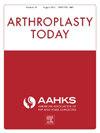为什么早期职业生涯的成人重建外科医生会跳槽?美国髋关节和膝关节外科医生协会青年关节成形术小组调查研究
IF 1.5
Q3 ORTHOPEDICS
引用次数: 0
摘要
背景据报道,骨科外科医生的职业倦怠和离职率很高。本研究旨在调查早期职业生涯的成人重建外科医生中工作变动的普遍程度,并研究哪些人口统计学或实践因素会影响工作变动。方法向美国髋关节和膝关节外科医生协会青年关节成形术小组的所有执业外科医生成员发放电子调查表。调查内容包括有关执业类型、人口统计学、工作变动的问题,以及一份经过验证的职业倦怠问卷。调查回复是通过安全数据库收集的。结果共有 201/389 份回复(51.7%)。最常见的跳槽动机是更好的工作场所文化(64%)、职业发展机会(52%)以及更好地与部门/机构的价值观保持一致(45%)。女性受访者人数较少,但她们的跳槽率呈上升趋势(35.6% 的女性对 21.3% 的男性,P = .3)。正在考虑更换工作但尚未更换工作的受访者在所有研究分量表中报告职业倦怠症状的可能性明显更高:情感衰竭(P = 0.0001)、人格解体(P = 0.0002)和个人成就感(P = 0.007)。结论更换工作的外科医生将工作场所文化等社会因素作为离职的原因。考虑更换工作的外科医生的职业倦怠症状较高,但已经更换工作的外科医生的职业倦怠症状有所改善。确定导致换工作的因素对于指导年轻外科医生选择工作和留住人才非常重要。本文章由计算机程序翻译,如有差异,请以英文原文为准。
Why Do Early-Career Adult Reconstruction Surgeons Change Jobs? An American Association of Hip and Knee Surgeons Young Arthroplasty Group Survey Study
Background
There are high reported rates of burnout and job turnover among orthopedic surgeons. The purpose of this study was to investigate the prevalence of job change among early-career adult reconstruction surgeons and to examine which demographic or practice factors influenced job change.
Methods
An electronic survey was distributed to all practicing surgeon members of the American Association of Hip and Knee Surgeons Young Arthroplasty Group. The survey included questions about practice type, demographics, job change, and a validated burnout questionnaire. Survey responses were collected using a secure database. Statistical analysis was performed to examine relationships between respondent characteristics and job change.
Results
There were 201/389 responses (51.7%). The most common motivators for job change were better workplace culture (64%), opportunities for career growth (52%), and better alignment with values of the department/institution (45%). There were few female respondents; however, they trended toward reporting higher rates of job change (35.6% female vs 21.3% male, P = .3). Respondents who were considering changing jobs but had not done so were significantly more likely to report symptoms of burnout in all studied subscales: emotional exhaustion (P < .0001), depersonalization (P = .0002), and sense of personal accomplishment (P = .007).
Conclusions
Surgeons changing jobs cited social factors such as workplace culture as reasons for leaving. Burnout symptoms were higher in surgeons considering changing jobs but improved in those who had already changed jobs. It is important to identify factors that lead to job change to guide young surgeons in job selection and improve retention.
求助全文
通过发布文献求助,成功后即可免费获取论文全文。
去求助
来源期刊

Arthroplasty Today
Medicine-Surgery
CiteScore
2.90
自引率
0.00%
发文量
258
审稿时长
40 weeks
期刊介绍:
Arthroplasty Today is a companion journal to the Journal of Arthroplasty. The journal Arthroplasty Today brings together the clinical and scientific foundations for joint replacement of the hip and knee in an open-access, online format. Arthroplasty Today solicits manuscripts of the highest quality from all areas of scientific endeavor that relate to joint replacement or the treatment of its complications, including those dealing with patient outcomes, economic and policy issues, prosthetic design, biomechanics, biomaterials, and biologic response to arthroplasty. The journal focuses on case reports. It is the purpose of Arthroplasty Today to present material to practicing orthopaedic surgeons that will keep them abreast of developments in the field, prove useful in the care of patients, and aid in understanding the scientific foundation of this subspecialty area of joint replacement. The international members of the Editorial Board provide a worldwide perspective for the journal''s area of interest. Their participation ensures that each issue of Arthroplasty Today provides the reader with timely, peer-reviewed articles of the highest quality.
 求助内容:
求助内容: 应助结果提醒方式:
应助结果提醒方式:


